Copier and printer toner primarily consists of plastic particles, color pigments, charge control agents, and various additives. The plastic resins make up 85-95% of the toner, providing the necessary consistency for printing. Color pigments guarantee accurate color representation, while charge control agents enhance adhesion to paper. Additionally, fumed silica improves the toner’s flow and prevents caking. Collectively, these components contribute to toner’s efficiency and quality, paving the way for deeper insights into its functionalities.

The intricate workings of a laser printer reveal a fascinating blend of technology and chemistry that transforms digital images into tangible prints. Central to this process is toner, which plays a vital role in laser printing efficiency and image quality.
Unlike ink, toner is a fine powder that adheres to paper through heat and pressure, resulting in sharp, vibrant prints. Effective toner efficiency maximizes output while minimizing costs, providing substantial cost savings for users.
Additionally, cartridge recycling initiatives promote environmental sustainability, allowing for the reuse of components without compromising print quality. By understanding the dynamics of laser printing and toner, users can optimize their printing practices, ensuring both high-quality results and economical performance in their printing endeavors.
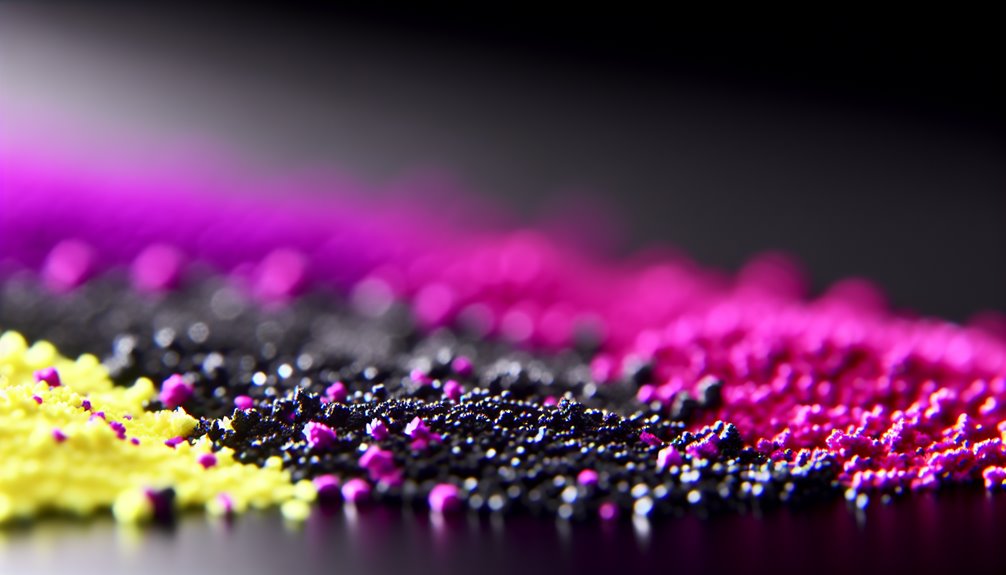
Toner, an essential component in laser printing, consists primarily of finely ground plastic particles, color pigments, and various additives. These materials contribute to its effectiveness in various toner applications, enhancing print quality and efficiency.
Recent toner innovations focus on reducing the environmental impact of toner production and usage, leading to the development of more sustainable options. Many manufacturers are now participating in recycling programs to minimize waste and promote eco-friendly practices.
Cost comparisons between toner types reveal that high-yield cartridges often provide a lower cost-per-page, making them an economical choice for high-volume printing. Understanding these elements allows users to make informed decisions regarding toner selection, further optimizing their printing processes.
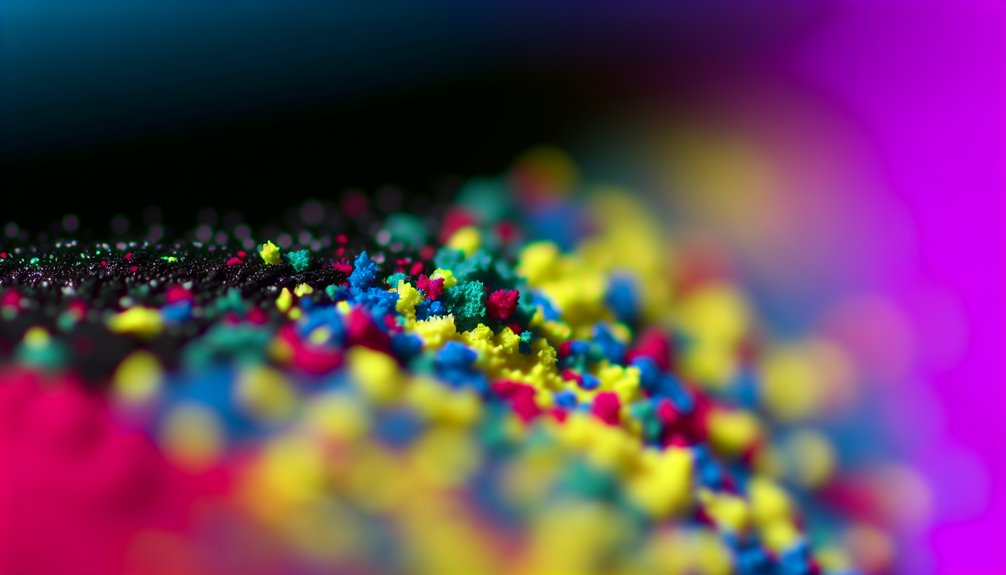
Understanding toner composition is essential for appreciating its role in laser printing.
Key components include plastic resins, which form the base, color pigments or carbon black for hue, charge control agents to enhance adhesion, and fumed silica as a flow additive.
Together, these elements create a finely tuned powder that guarantees high-quality print output.
At the core of toner composition lies a variety of plastic resins that play an essential role in its function and performance. These resins, primarily polyester, constitute 85-95% of toner, greatly influencing toner quality and image resolution.
Their low melting point enables efficient fusing during the printing process, enhancing overall printing technology. Additionally, manufacturers increasingly explore eco-friendly options, utilizing biodegradable plastic resins to reduce environmental impact without compromising functionality.
Such innovations not only address sustainability concerns but also present cost-effective solutions for consumers seeking high-quality prints at lower expenses. By understanding the importance of plastic resins, users can make informed choices regarding toner selection, ensuring peak performance and environmental responsibility.
Color pigments and carbon black are fundamental components that contribute to the visual quality and performance of toner. These materials guarantee color consistency, enhance printing efficiency, and affect toner longevity. While carbon black provides a deep black hue, color pigments like Yellow 180 and Red 122 are essential for vibrant color reproduction. Their stability is critical for maintaining print integrity over time, reducing the risk of fading. Additionally, the environmental impact of toner production is increasingly important, as manufacturers seek eco-friendlier alternatives.
| Component | Function | Environmental Impact |
| Carbon Black | Provides black color | Potentially harmful |
| Yellow Pigment | Enhances yellow hues | Lower impact options |
| Magenta Pigment | Produces rich reddish tones | Increasingly sustainable |
| Cyan Pigment | Creates bright blue colors | Eco-conscious methods |
Charge control agents play an essential role in the composition and functionality of toner, ensuring that particles maintain their electrostatic charge during the printing process.
These agents facilitate the charge control mechanism, which is critical for effective toner particle adhesion to the imaging drum and paper. By optimizing electrostatic attraction, charge control agents enhance toner performance and contribute to overall printing cost efficiency.
Incorporating these agents is crucial for achieving high-quality prints and maximizing printer efficiency.
Fumed silica serves as a critical flow additive in toner formulations, enhancing the overall performance and efficiency of the printing process. Its microscopic glass beads improve the flow characteristics of toner, preventing caking and guaranteeing consistent delivery during toner application techniques. The benefits of fumed silica are particularly evident in the influence of particle size, as smaller particles facilitate better dispersion within toner blend variations.
| Fumed Silica Benefits | Flow Additive Importance |
| Enhances toner flow | Prevents toner caking |
| Improves print quality | Guarantees consistent application |
| Increases efficiency | Reduces downtime |
| Facilitates uniformity | Aids in precise toner control |
| Supports various formulas | Optimizes performance |
Incorporating fumed silica is critical for achieving high-quality printing outcomes.
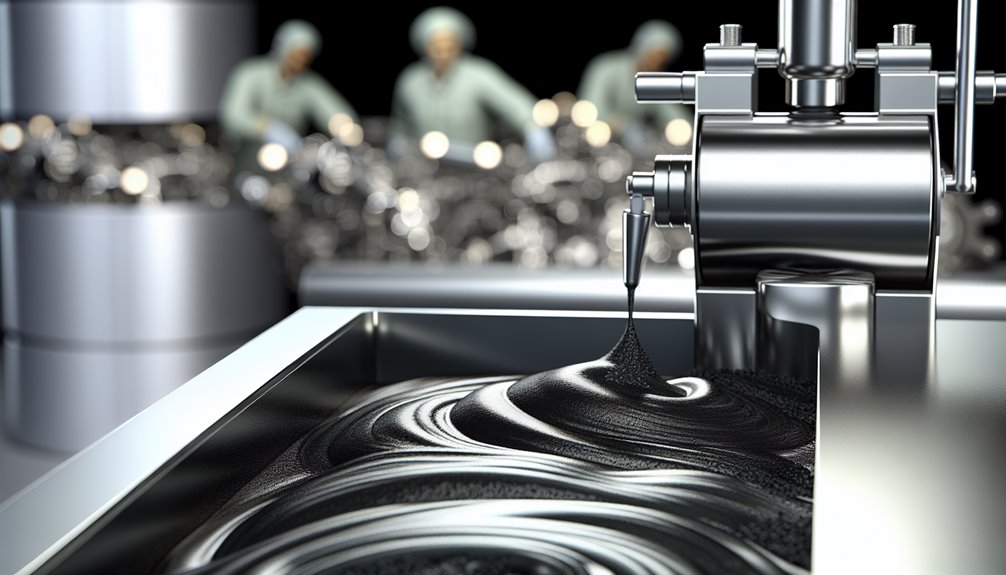
Toner manufacturing has evolved considerably from its early days when plastic slabs were crushed into powder, resulting in uneven particle sizes.
Today, manufacturers utilize advanced techniques to chemically grow uniform toner particles, enhancing the quality and efficiency of the final product.
This shift in production methods not only improves print quality but also optimizes the overall performance of laser printers.
Historically, the production of toner involved a labor-intensive process where plastic slabs were crushed into a fine powder, resulting in an inconsistent particle size. This early method of toner manufacturing faced numerous challenges that hindered printing technology advancements. The uneven particle size affected print quality, leading to less vibrant images and inefficiencies.
These factors ultimately prompted a shift towards more sophisticated approaches, paving the way for modern advancements in toner production and improved printing capabilities.
The modern manufacturing method of chemically growing uniform toner particles has greatly enhanced image quality in printing.
This technique guarantees consistent particle size, leading to improved toner efficiency and performance.
As a result, printers can achieve sharper images and more reliable results, meeting the demands of today's high-quality printing standards.
Advancements in toner manufacturing have revolutionized image quality in laser printing. The shift toward chemically grown uniform toner particles enhances printing efficiency and reduces toner costs, while also minimizing environmental impact.
Key benefits include:
These innovations position modern toner technology as an essential component of professional-grade printing.
Chemically grown uniform toner particles represent a significant leap in toner manufacturing, enhancing both efficiency and consistency in laser printing.
This modern technique produces particles that are smaller and more uniform, thereby improving toner efficiency and image quality.
Such advancements in printing technology not only elevate toner consistency but also reduce environmental impact by minimizing waste and energy consumption during the printing process.
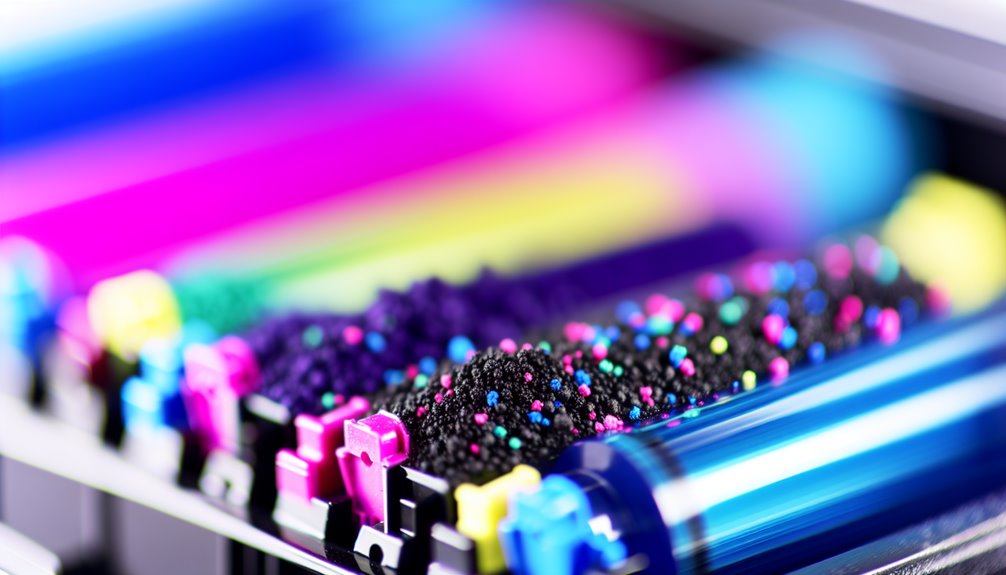
In a copier or laser printer, the process begins when the printer receives a command to produce an image.
A laser creates a static charge on the imaging drum, allowing toner with an opposite charge to adhere to the intended design.
As paper passes through, the fuser applies heat and pressure, melting the toner so it bonds securely to the surface, resulting in a final printed output.
Upon receiving a print command, the laser printer initiates a series of precise steps to produce the desired output. This process begins with the printer interpreting the command and preparing the necessary toner applications for the job.
Key considerations during this stage include:
These initial steps are essential for optimizing performance, ensuring high-quality prints, and adhering to best practices in printing technology, setting the stage for the subsequent phases of the printing process.
Following the receipt of a print command, the laser printer employs a sophisticated method to create an image on the drum using a static charge.
This process, known as laser imaging, involves a laser beam that writes the desired image onto the photoconductive drum. As the beam strikes the drum, it selectively discharges areas, creating a pattern of static electricity that corresponds to the image.
The toner particles, which are electrically charged, are then attracted to these charged areas on the drum. This precise method of image transfer is vital for ensuring high-quality prints.
The intricate process of toner adhesion plays a pivotal role in the quality of prints produced by copiers and laser printers. When the imaging drum is charged, it attracts toner particles with an opposite charge, ensuring accurate image transfer. This electrostatic attraction is critical for achieving sharp, vibrant prints and is influenced by several factors:
As toner innovations continue to evolve, so does the potential for improved efficiency and reduced environmental footprint. This highlights the importance of mastering the nuances of toner adhesion in printing technology.
As paper moves through a copier or laser printer, it encounters the toner layer on the imaging drum, where the electrostatic charge facilitates the transfer of toner particles onto the paper's surface. This process employs various toner application techniques, enhancing print quality and efficiency. Understanding the lifespan of toner cartridges is critical, as it influences printer performance and cost-effectiveness. Proper toner storage tips, such as keeping cartridges in a cool, dry environment, can extend lifespan. Additionally, awareness of toner recycling methods promotes sustainable practices. The following table summarizes key toner usage statistics to enhance comprehension:
| Statistic | Value | Importance |
| Average Cartridge Lifespan | 2,500 pages | Cost efficiency |
| Recycling Rate | 20% | Environmental impact |
| Storage Temperature | 60-80°F | ideal performance |
| Application Techniques | Electrostatic | Precision in printing |
| Annual Usage Increase | 10% | Growing printing demands |
Once paper has picked up the toner from the imaging drum, it moves towards the fuser, where heat and pressure are applied to bond the toner to the paper.
This vital step utilizes advanced fuser technology to guarantee effective toner adhesion, enhancing overall printing efficiency. The characteristics of the toner powder play a significant role in this process, as the low melting point allows the particles to fuse seamlessly.
This combination of heat and pressure ultimately defines the quality of prints produced by laser printers.
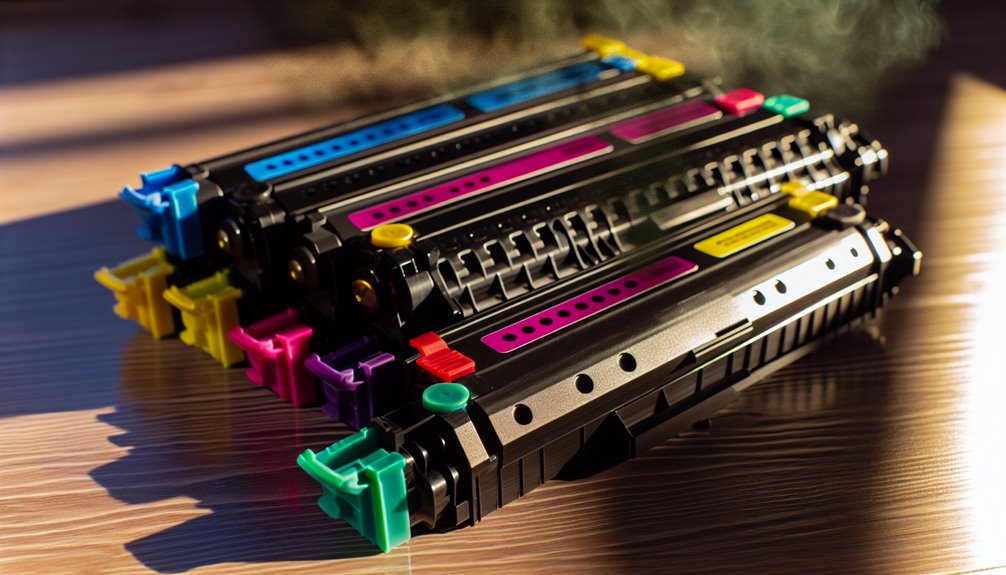
Different types of toner cartridges play a vital role in laser printing efficiency and cost-effectiveness.
OEM cartridges, produced by manufacturers, offer reliability but at a higher price, while compatible cartridges serve as more affordable alternatives, though they may vary in quality.
Remanufactured cartridges provide an eco-friendly option by recycling OEM products, balancing cost and environmental considerations.
OEM toner cartridges are produced by the printer manufacturers, such as HP, Canon, and Brother, ensuring peak performance and reliability.
These cartridges are designed specifically for their respective printers, resulting in the highest consistency in print quality and page yields.
While typically more expensive than alternatives, their dependable performance makes them a preferred choice for many users.
High-quality toner cartridges are essential for achieving ideal print performance in laser printers, and those manufactured by the printer brands themselves, such as HP, Canon, and Brother, are commonly referred to as OEM (Original Equipment Manufacturer) cartridges.
These factors contribute greatly to reliability and performance.
When it comes to achieving ideal print performance and consistency, toner cartridges made by the original printer manufacturers stand out as the preferred choice.
These OEM cartridges guarantee toner longevity and maximum cartridge compatibility, enhancing print quality while maintaining cost efficiency.
Additionally, they have a lower environmental impact compared to alternatives, making them the best option for both quality-conscious and eco-friendly consumers.
Compatible toner cartridges are third-party alternatives designed to fit various printer models, often at a lower cost than OEM options.
While they can provide significant savings, their quality can vary widely, leading to potential issues such as leaks, poor print quality, and even damage to printers.
Users should weigh these risks against their budgetary needs when considering compatible cartridges for their printing solutions.
Although compatible toner cartridges offer a cost-effective alternative to OEM options, their quality can vary considerably.
This variability raises several important considerations for consumers:
Understanding these factors is essential for informed consumer preferences and best printing results.
The use of compatible toner cartridges, while appealing due to their lower cost, carries several risks that can considerably impact both print quality and printer functionality.
Toner leaks can lead to messy printouts and potential printer damage. Additionally, inconsistent cartridge lifespan may necessitate frequent replacements, ultimately increasing costs.
Adhering to maintenance tips is essential to mitigate these risks and guarantee peak performance.
Remanufactured toner cartridges are recycled OEM cartridges that have been cleaned and refilled for reuse.
These cartridges offer an eco-friendly alternative, reducing waste while potentially lowering printing costs.
However, the quality of remanufactured cartridges can vary considerably based on the source and manufacturing process.
Sustainability plays an essential role in the choice of toner cartridges, particularly with remanufactured options that breathe new life into recycled OEM cartridges.
This remanufacturing process offers:
While offering a more environmentally friendly option, remanufactured toner cartridges vary greatly in quality depending on their source.
Eco-friendly alternatives can greatly reduce environmental impact through effective recycling toner cartridges and sustainable sourcing of toner materials.
However, the quality of these cartridges may fluctuate, necessitating careful selection to guarantee peak performance and toner production sustainability, ultimately enhancing user satisfaction and print results.
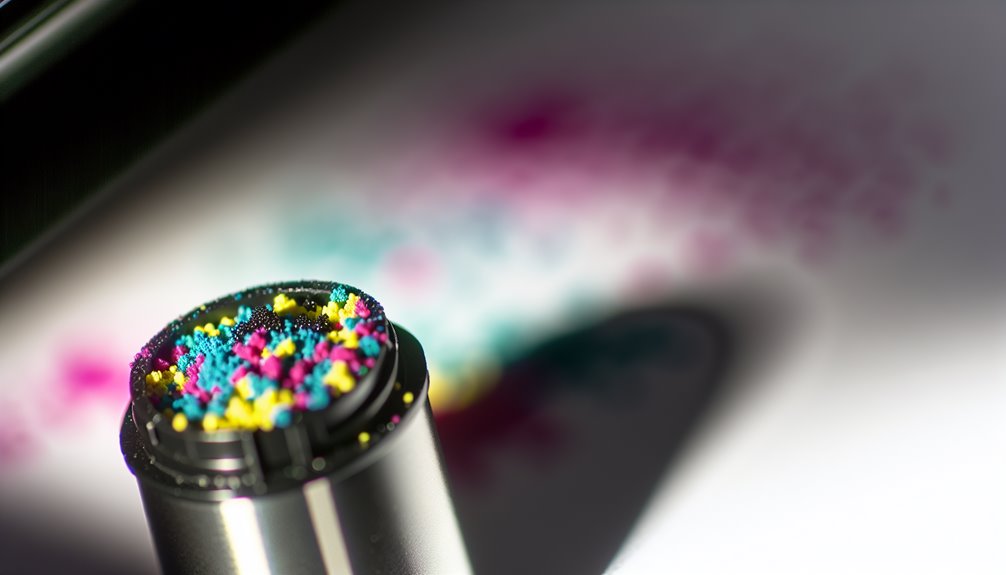
Understanding page yield is essential for evaluating toner longevity and cost-effectiveness.
Toner cartridges are classified by their yield capabilities, ranging from standard to high and extra high-yield options, each designed to meet different printing needs.
The actual yield can vary based on printer model and usage patterns, typically measured under a 5% coverage standard.
When evaluating toner cartridges, one vital aspect to take into account is their page yield, typically measured based on a standard coverage of 5%. This benchmark helps consumers understand how long a toner will last under average usage conditions, which can vary considerably among different toner types.
Key considerations include:
Evaluating these factors is essential for maximizing efficiency and managing printing costs effectively.
Understanding the types of page yields is essential for optimizing printing efficiency and cost.
Standard yield cartridges typically produce around 1,000 to 1,500 pages, while high-yield options increase that output to approximately 2,500 to 3,500 pages.
For those in high-volume environments, extra high-yield cartridges can exceed 4,000 pages, offering significant savings for frequent users.
Standard yield toner cartridges typically produce between 1,000 to 1,500 printed pages, making them suitable for users with light printing needs.
These cartridges provide a balanced approach for casual printing while promoting sustainable practices.
High-yield toner cartridges are designed for users with moderate to heavy printing needs, offering a page yield of approximately 2,500 to 3,500 pages.
These cartridges provide significant high yield benefits, enhancing toner longevity and reducing printing costs.
Additionally, they can minimize the environmental impact by decreasing waste.
Ensuring cartridge compatibility with specific printers maximizes efficiency and performance in printing tasks.
Extra high yield toner cartridges cater to users with extensive printing needs, offering an impressive page yield ranging from 4,000 to over 10,000 pages.
These cartridges provide significant advantages, including:
Careful cartridge selection guarantees peak performance and sustainability.
The yield of toner cartridges is influenced by several factors, including cartridge quality, the type of printing performed, and the specific printer model used.
For instance, printing text typically yields more pages compared to printing high-resolution images, which can consume toner more rapidly.
Understanding these variables is essential for optimizing toner usage and achieving cost-effective printing results.
Cartridge quality greatly impacts page yield, determining how long a toner cartridge lasts during use.
Factors influencing this include:
Investing in quality cartridges can enhance efficiency and sustainability.
Print quality and longevity are influenced not only by cartridge quality but also by the type of printing being conducted.
Text printing typically requires less toner than image printing, affecting toner efficiency and output consistency.
High-resolution images demand more toner, leading to variations in print quality.
Understanding these differences helps users optimize their printing strategies for both text and images effectively.
Determining how long toner lasts largely depends on the specific printer model in use.
Factors influencing toner longevity include:
Understanding these elements aids in achieving better color accuracy and enhancing overall maintenance efficiency.
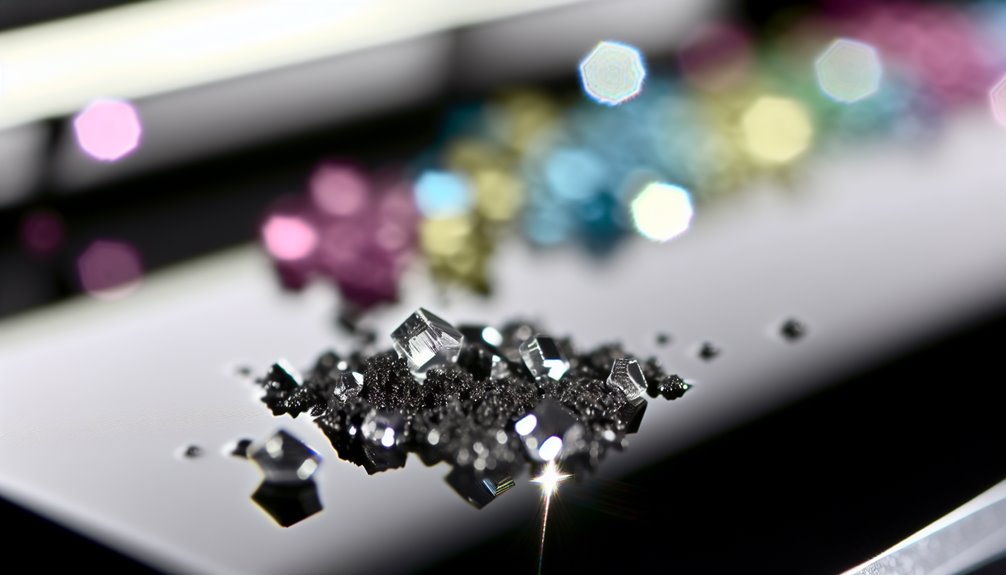
Toner offers several advantages over ink, making it a preferred choice for many printing needs.
It does not dry out over time, allowing for consistent performance, and typically prints faster with sharper text and greater durability.
Additionally, toner delivers a lower cost per page, making it ideal for high-volume printing environments.
While many consumers appreciate the rich colors produced by inkjet printers, the longevity of toner cartridges offers a significant advantage in most printing scenarios.
Toner longevity guarantees that users do not face the inconvenience of dried-out cartridges, a common issue with liquid ink. The powdered consistency of toner contributes to its resilience, making it ideal for infrequent use.
Key benefits include:
Laser printers equipped with toner cartridges excel in speed, delivering rapid printouts that often surpass the capabilities of inkjet printers. This enhanced toner efficiency is a key advantage, especially in environments that demand high-volume output.
Unlike ink, toner’s powdered form facilitates quicker processing and fusing, markedly reducing print times. Additionally, the longer cartridge lifespan associated with toner cartridges minimizes interruptions for replacements, streamlining printer maintenance.
The precision of printing technology used in laser printers also contributes to superior color accuracy, ensuring vibrant and consistent results.
For organizations prioritizing efficiency and speed, the choice of toner over ink becomes an evident decision, supporting a more productive workflow.
The advantages of using toner extend beyond speed, particularly regarding text sharpness and print durability. Toner applications deliver high-resolution prints that maintain clarity, making them ideal for professional documents. This results in:
Additionally, the environmental impact of toner, when compared with ink, often results in less waste.
Effective printer maintenance becomes essential to maximize these benefits, while a cost analysis shows that investing in toner can yield significant savings over time.
In many cases, the overall cost per page for toner is considerably lower than that of ink, making it a more economical choice for frequent printing needs. This cost efficiency stems from toner’s ability to yield more pages per cartridge, enhancing printing longevity.
High-yield toner options also reduce the cost per page, appealing to businesses with substantial printing demands. Additionally, cartridge compatibility with various printer models guarantees that users can find suitable options without significant investment.
Toner conservation is also a factor, as it does not dry out like ink, minimizing waste. Moreover, the environmental impact of toner cartridges can be mitigated through recycling programs, promoting sustainability in printing practices.
High-volume printing environments benefit greatly from the use of toner over ink.
Toner provides significant advantages that enhance operational efficiency and reduce costs, making it the preferred choice for businesses demanding high volume efficiency.

In 1969, Xerox engineer Gary Starkweather introduced laser printing, marking a pivotal moment in printing technology.
Initially, toner was a rudimentary mix of carbon powder, but it has since transformed into precisely engineered plastic particles designed for peak performance.
Today’s toner not only enhances printing quality and efficiency but also adheres to environmental standards.
Revolutionizing the printing landscape, Xerox engineer Gary Starkweather invented laser printing in 1969. This groundbreaking technology redefined the laser printing evolution, bridging the gap between traditional photocopying advancements and modern printing technology.
Starkweather's contributions led to the development of efficient, high-quality printing processes that emphasized speed and precision.
The invention transformed the industry, paving the way for laser printers to dominate the market.
Starkweather's vision not only enhanced productivity but also established a new standard for quality, demonstrating the profound impact of technological advancement in the world of printing.
Toner has undergone a remarkable transformation from its early days as a crude mixture of carbon powder to the sophisticated precision plastic particles used in modern laser printing.
Early toner history relied heavily on carbon black and iron oxide, often resulting in subpar color quality. Advances in printing technology have led to the development of finely engineered plastic particles that enhance image resolution and reduce environmental impact.
The smaller particle size allows for better adhesion during the printing process, improving efficiency and print quality. Additionally, the cost comparison between old and new formulations highlights significant savings in high-volume printing, as modern toners produce more pages at a lower cost-per-page, making them a preferred choice for businesses and consumers alike.
Engineered for peak performance, today’s toner blends advanced materials and precise formulations to enhance printing efficiency and quality. Innovations in toner manufacturing have led to significant advancements, resulting in products that align with environmental compliance and sustainability goals.
As toner market trends shift towards eco-friendly solutions, manufacturers are committed to producing high-quality toners that not only meet performance standards but also contribute positively to environmental stewardship.
This evolution reflects the industry's response to consumer demands for sustainability.
Toner cartridge recycling and refilling offer eco-friendly options, promoting sustainability benefits. These cost-saving alternatives reduce waste, conserve resources, and encourage responsible consumer behavior, contributing to a more efficient printing ecosystem while minimizing environmental impact.
Toner dramatically influences printer maintenance, as its lifespan and quality dictate performance. High-quality toner reduces maintenance frequency, ensuring efficient operation while enhancing cost efficiency, ultimately transforming printers into reliable workhorses in any demanding environment.
A toner spill requires prompt cleanup to minimize environmental impact. Effective prevention includes spill containment methods and following safety precautions, ensuring proper disposal of toner waste while maintaining a clean workspace and reducing contamination risks.
In the delicate world of toner cartridges, proper storage is essential. Toner storage tips include keeping cartridges in original packaging, at an ideal temperature, ensuring humidity control, and recognizing shelf life to maintain peak performance.
Health risks associated with toner include potential toner irritation and allergies, particularly from toner inhalation. Proper toner safety measures can mitigate exposure, reducing the likelihood of respiratory issues or allergic reactions in sensitive individuals.
In the intricate dance of modern printing, toner emerges as the silent artist, transforming blank pages into vibrant canvases. Composed of finely powdered plastics and pigments, it weaves a tale of efficiency and durability that ink struggles to match. As technology advances, toner continues to evolve, promising sharper images and longer-lasting prints. Understanding its composition and benefits not only enhances appreciation for this unsung hero but also enriches the overall printing experience, ensuring that every page tells a vivid story.
So good! So good! So good! So good! So good! So good!